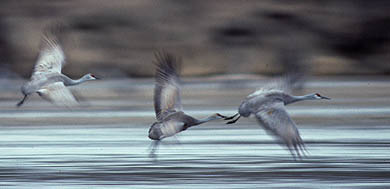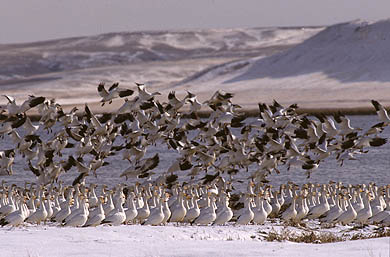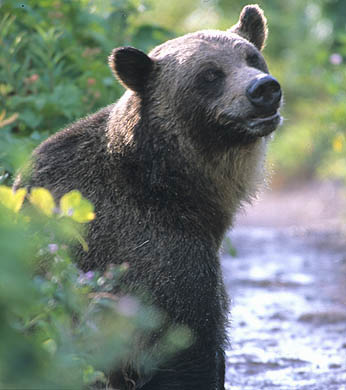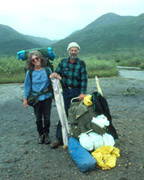Spring Awakening & G-bear Delisting
Note: For the next few months we will be posting this blog on a weekly basis—unless there is some subject of such compelling interest that we can’t turn away. This extra time will give us a chance to catch up on our obligations to other outlets, so that we can then resume our travel adventures. Please continue to check in.
©Bert Gildart: Over the past 20 years, RV travel has enabled Janie and me to form opinions about events happening across our nation. In other words, we’ve personally enjoyed such major events as grizzly bears emerging from their dens, and the massive bird migrations—all associated with spring. In very different parts of the country, these spectacles are occurring—right now.
 SANDHILL CRANES ON THE PLATTE RIVER: Noted ornithologist Roger Tory Peterson once remarked that the sandhill crane migration to the Platte constitutes one of the world’s greatest wildlife spectacles.
SANDHILL CRANES ON THE PLATTE RIVER: Noted ornithologist Roger Tory Peterson once remarked that the sandhill crane migration to the Platte constitutes one of the world’s greatest wildlife spectacles.
Cranes have always amazed people whether they are in Nebraska or anywhere else in the world. In Russia, people are so moved by the beauty of cranes that when a soldier dies, they say his soul enters a crane’s body. Then the crane spreads its wings and the soldier’s soul soars into heaven.
Cranes are the world’s oldest birds, older than robins, eagles, pelicans or storks. Cranes are over 50 million years old! In 1979, scientists found a fossilized wing along the Platte River that was over nine million years old. It belonged to a sand hill crane, so sandhills have been in North America at least that long.
The story of the Platte River sandhill crane congregation might well begin in Mexico or Texas where the birds winter. About the end of February, when temperatures begin to rise and the length of days increase, cranes begin their northern migration, flying at speeds of 25 to 35 miles per hour at elevations that can exceed 13,000 feet. By the time cranes complete their journey, some will fly almost 4,000 miles.
But to fly that far requires stored energy, and lots of it. So sandhills divide the trip up, flying first to a staging area, in this case, the Platte River. Here, they find corn and the protection on sandbars they need at night to isolate them from predators, such as coyotes. Should water be drawn down, coyotes could easily swim to sandbars.
Cranes remain along the Platte until they have rested and replenished their fat reserves. Then they strike north again, once again thrilling people with their haunting calls.
 FREEZEOUT LAKE: Much the same is happening all across North America, and another of these staging areas is in Montana, and right now, as I write these words, snow geese are settling onto a lake in the Big Sky known as Freezeout Lake. Here, during record years, 500,000 snow geese have gathered.
FREEZEOUT LAKE: Much the same is happening all across North America, and another of these staging areas is in Montana, and right now, as I write these words, snow geese are settling onto a lake in the Big Sky known as Freezeout Lake. Here, during record years, 500,000 snow geese have gathered.
Unlike the cranes of the Platte River, a spectacle now threatened because of the withdrawal of river water, the spectacle of snow geese congregations in Montana appears to have adequate safeguards. Were that it so for the Yellowstone grizzly bears that we have been reading about so much this past weekend.
Grizzlies, as some readers certainly know, may soon be removed from the Endangered Species List. The proposed lifting of U.S. Endangered Species Act (ESA) protection for grizzlies in the so-called Greater Yellowstone Area follows a 30-year period of recovery. In that time Yellowstone grizzly numbers have grown from 200 to more than 600.
 GRIZZLY BEAR—IN SUMMER: Still, most say “It’s too soon,” and then they enumerate the reasons. Essentially, they say that because bears range outside the park many will be shot. Once the bear’s habitat is no longer protected under the ESA, development, logging, road building, and new oil and gas operations will be major threats.
GRIZZLY BEAR—IN SUMMER: Still, most say “It’s too soon,” and then they enumerate the reasons. Essentially, they say that because bears range outside the park many will be shot. Once the bear’s habitat is no longer protected under the ESA, development, logging, road building, and new oil and gas operations will be major threats.
With such pressures many believe the delisted bear will soon be listed once again. In the interim, one of nature’s truly great creatures will be diminished.
Perhaps more than some, RVers seem to enjoy their national parks and wildlife experiences. Writing representatives to protest the delisting of bears is a worthy endeavor, and comments are now being taken—and considered. Why not add yours?
In the meantime, the cranes and geese are back in staggering numbers and bears will soon be emerging. You might begin your search of bears in Yellowstone’s Lamar Valley, open all year long. Look for bears at the base of avalanche chutes and around the sites of winter kills. Keep your eyes open, too, for cranes and snow geese, which you might spot most anywhere in the Midwest and the West.

